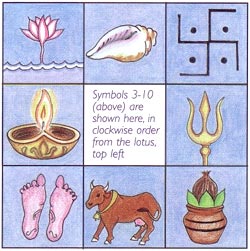
Symbols in Hinduism
Hinduism is rich in symbolism. Many acts of worship, such as puja, are symbolic, a form of visualisation in which worshippers simulate activities normally performed on higher planes of existence. Thus the scope of symbolism is broad and includes physical acts such as offering pranam(obeisances) with folded hands. Such physical gestures tend to induce the appropriate mood and awareness within the practitioner. Many symbols are considered auspicious, embodying the notion of inner purity. Sacred emblems are displayed in the home or temple to invoke good fortune. The most popular symbols are listed on the right.
Aum, also written "Om" and called pranava, is the most important Hindu symbol. Its prolonged intonation is associated with the primeval sound through which the universe was created. It is thought to contain all things. It consists of three syllables — a-u-m — which are sounded progressively from the throat to the lips. The three sounds are considered to symbolise many items, but perhaps most importantly the three states of consciousness – waking, dreaming, and deep sleep. The entire symbol represents the fourth state, which is the awareness of one's own spiritual identity. Aum is the most important mula (root) mantra and is thus chanted at the beginning of many prayers, mantras, and rituals.
Hindu people greet each other by placing their two hands together and slightly bowing the head, whilst saying namaste or a similar phrase. They adopt the same posture when greeting the temple deity or a holy person. Thus when greeting another person, a Hindu is offering respect to the soul within (atman) and also to God within the heart (Paramatman).
Ten Important Symbols
- Om (Aum) – the most important Hindu symbol, often used as the emblem of Hinduism (see above).
- Hands in prayer – a sign of respect for the sacred, that which is dear to the heart (see above).
- Lotus (padma) – symbol of purity/transcendence. Growing out of the mud, it is beautiful, and though resting on water, it does not touch it.
- Conchshell – used during arati: one of the four symbols of Vishnu. The others are the lotus, club and disc.
- Swastika – an ancient solar sign considered to invoke auspiciousnes.
- Trident (trishul) – the symbol of Shiva; often carried by Shaivite sannyasis (renunciates).
- Kalasha – coconut circled by mango leaves on a pot. Often used in rituals such as the fire sacrifice.
- Cow – symbol of purity, motherhood and ahimsa (non-violence).
- Lotus feet (of guru or deity) – touching the feet of superiors shows an attitude of submission and service.
- Dipa/lamp – symbol of light.




